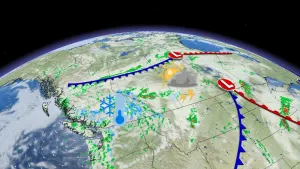
Huge growth potential for green jobs during Canada’s energy transition
Much of the transition will be focused on the energy sector, but the rapid pace of change and growth comes with challenges.
In 2020, the employed Canadian workforce shrank on average, but even amid the pandemic there was a net gain of 35,000 green jobs.
By 2025, jobs across the labour force are projected to grow by slightly more than five per cent, while all green jobs — not just those in the energy sector — will see a rise of around 17 per cent, according to research.
According to a report by Clean Energy Canada, Canada’s clean energy workforce is projected to grow from 430,500 employees today to 639,200 by 2030 — an increase of close to 50 per cent — while the fossil fuel sector will lose some 125,000 jobs (or nine per cent) over that same period.
An explosion of green jobs is also expected in transport, housing, climate adaptations, and aquaculture. Estimates show that in just the next few years there will be a wave of some 170,000 green job openings.
“Green jobs are growing in Canada faster than employment overall in the workforce,” Geni Peters, director of research at Eco Canada, told The Weather Network. “Much of the growth has been initiated by changes in government policy and through initiatives by NGOs and private citizens as well.”
Peters added, “All of these initiatives are driving demand for jobs at all levels — technical jobs like engineers, scientists, climatologists; trades jobs like heavy equipment operators, carpenters, electricians; people in the policy realm, including communications between Indigenous communities and other sectors.”

Construction at TransAlta’s 130 MW Garden Plain wind farm, located near Hanna, Alta. (Rachel Maclean/The Weather Network)
Much of the transition — be it in the workforce or in infrastructure — will be focused on the energy sector, as Canada puts policies in place to meet its Paris agreement commitments on climate change.
“We’re at a critical point where we see government stakeholders providing powerful incentives for companies to transition,” Nicole Flanagan, climate solutions lead with the global design firm Stantec told TWN.
“The biggest change is that we need to move beyond just target-setting and establishing goals to really being able to implement these measures,” Flanagan added.
Of course, the rapid pace of change and growth comes with challenges.
“While Canada has made progress in developing the necessary infrastructure to support the growth of the green economy, more investment and innovation is needed to fully realize the potential,” Priyanka Lloyd, the executive director of Green Economy Canada, told The Weather Network.
“On the physical infrastructure side, demand for electricity is projected to double by 2030,” Lloyd said. “Transitioning away from fossil fuels requires that we have an electricity grid capable of handling the increased demand that will come from EV adoption, solar projects, and fuel switching in how we heat and cool our buildings.”
WATCH BELOW: Battery company uses geothermal energy for production
“On the transportation side, EV Charging infrastructure also requires significant expansion and investment,” Lloyd added.
Yet even as businesses shift and new infrastructure is built, the biggest obstacle to a smooth transition to a green economy may be the workers themselves.
Experts expect critical shortages in all sorts of green vocations, from equipment officers and contractors, to technicians and engineers, to managers and inspectors.
“Making the transition to net zero is going to be contingent on having the resources, having the workers to be able to support these large projects,” Flanagan said.
On the other side of the equation will be the jobs lost in sectors that are “transition-vulnerable,” in particular the fossil fuel industry.
A report from the Canadian Climate Institute determined that “there are workers in transition-vulnerable sectors in every province and territory,” with a full 9.1 per cent of Alberta workers being transition-vulnerable.
It will be essential to ensure there is enough training and education for workers making mid-career changes or applying their skills in new sectors, and for new employees looking to start a career in burgeoning “green fields.”
To that end, programs have begun popping up like the University of Waterloo’s Climate and Environmental Change undergraduate degree, which opens the path to careers like renewable energy specialist or environmental consultant.
There is also s a host of government- and industry-sponsored training programs for transitioning workers into the green economy.
With the shift well underway, the cost of carbon emissions rising, and the increased incentives to “go green,” companies may find they have little choice but to join the wave. As Flanagan said, “today companies face the biggest risk by not transitioning.”
Thumbnail image: Person wearing gloves holding a power tool on a solar panel (Markus Spiske/Pexels).










